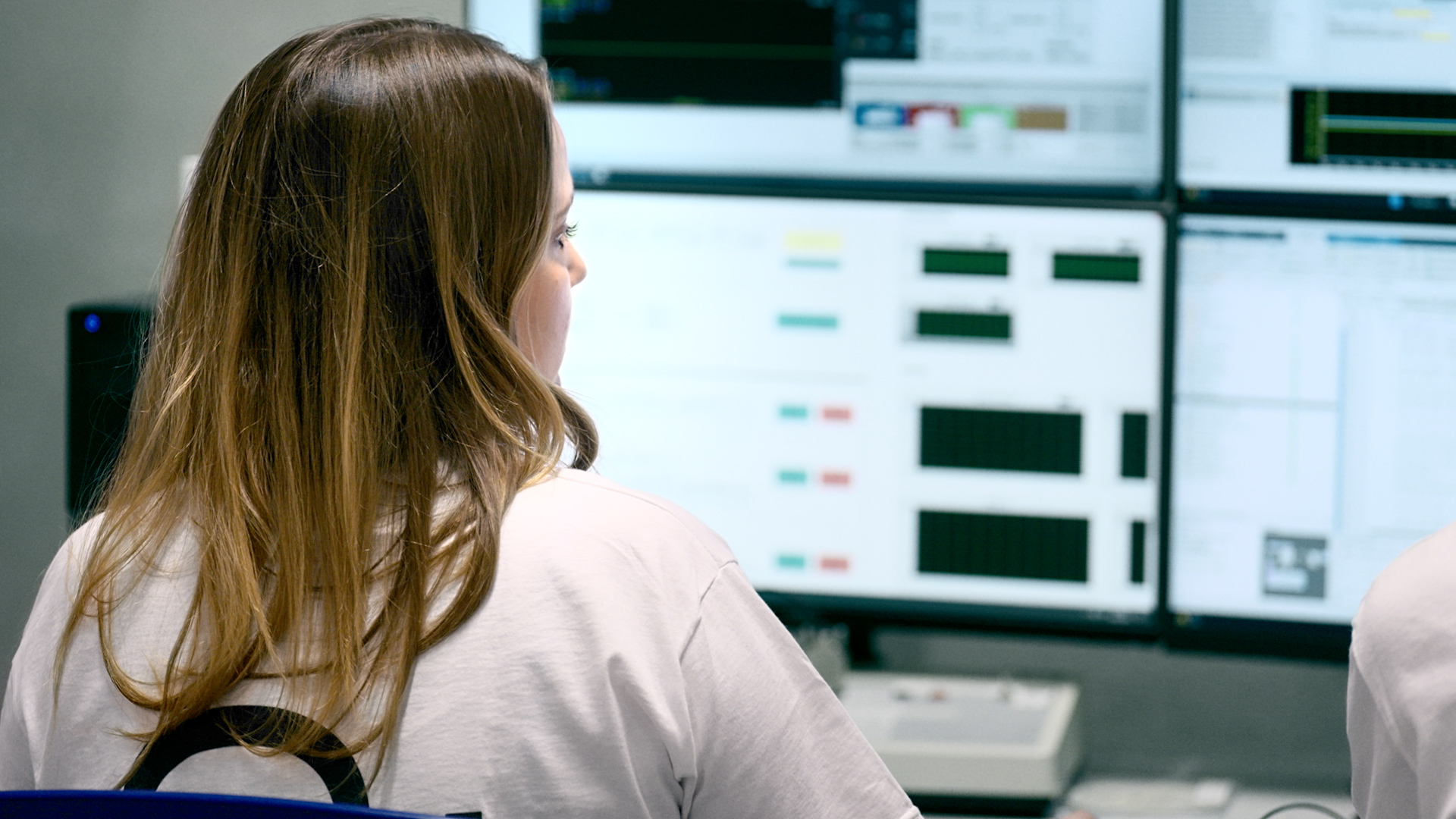News
On mechanical engineering and Corner Modules: Meet Zoé WeicherdingMeet our Engineers
Meet our Engineers
2023 / 01 / 20
Last week, we talked to Stefan and Felix about the most apparent automotive trends at CES 2023. One of these trends was definitely electrification and many electric vehicle manufacturers additionally focused on Electric Corner Modules (ECMs). This week, we talked to Zoé Weicherding, one of our Mechanical Engineers, to learn more about ECMs and how we at DeepDrive lay the foundation for enabling this trend.
Zoé joined our team in September 2022 after finishing her Master’s degree in Automotive Engineering at TU Munich. We got to know Zoé already years ago during our time at TUfast, the University motorsport team, where she was responsible for steering systems, bell crank & anti-roll bars as well as vehicle dynamic control. Zoé has a great fascination for motor technology and sees the e-motor as the „perfect interplay between mechanical engineering, software, and electric technology“. Thus, she highly values the fact that at DeepDrive all these disciplines sit together at one table instead of in completely different departments as is often the case in large corporates. This, in her point of view, is the „perfect breeding ground for innovation“ which we are so proud of at DeepDrive. She is an impeccable Engineer, but we also very much value her impressive dart skills.
Electric Corner Modules
Zoé told us that ECMs are per se not a new trend, still, the common nominator regarding ECM always was: „nice idea, never going to happen“. The idea behind an ECM is to integrate steering, drivetrain, suspension, and brakes in the wheels instead of the chassis which enhances design flexibility and offers additional space, due to the absence of the transmission and engine.
This idea became more and more attractive lately, especially due to the raise of purpose-built vehicles, such as autonomous vehicles and electric light commercial vehicles (eLCVs). These vehicles depend on space and ECMs can drastically increase the required volumes for cargo or passengers, making ECM-equipped vehicles the ideal solution as they can carry up to 30% more volume than a similar-sized vehicle with a central drive. ECMs furthermore allow moving the vehicle much more accurately, which is an especially useful feature for large and busy cities.
However, as mentioned before, the already existing idea of ECMs did not translate into reality. This is due to three main reasons:
▪ physics
▪ implementation
▪ and economic viability
The first reason, physics, relates to a physical consequence that appears when more weight is added to the wheels. Unsprung weight moves up and down with the wheels as they travel over obstructions, making wheels, tires, brake assemblies, differential, hub motors, and anything directly connected to the wheel unsprung mass. In general, it’s best to have a high ratio of sprung-to-unsprung weight, to not reduce driving comfort. As in-wheel or wheel near motors are integrated into the wheel, they add directly to the vehicle’s unsprung mass since they are located „before“ the suspension when starting from the road surface.
The second reason, implementation, stems from the fact that many modules must be united inside or near the wheel. This leads to a so-called „package war“ as the attempt often creates conflicts around the limited space that can be used.
Finally, the third reason why ECMs never really caught on is economic viability. There has simply not been an economically viable way to develop in-wheel motors. In fact, in-wheel motors are much more expensive than a conventional electric motor and even though there are commercial benefits to the technology, nobody is willing to pay more.
However, we at DeepDrive managed to solve these core issues by significantly increasing efficiency, and drastically reducing the weight and costs of our in-wheel motor. By doing so, we are enabling the trend of E Corner Modules with our technology and will play a key role in making the industry future-proof.
Efficiency
The DeepDrive wheel hub drives use a motor topology based on a highly innovative radial flux dual rotor approach with novel winding technology. It combines high specific torque densities of up to 60 Nm/kg, low raw material consumption, and excellent NVH performance. A yoke-less design of the stator reduces iron losses and leads to very high efficiency, especially in the partial load range.
The effective and already validated cooling concept enables a continuous torque of more than 1,000 Nm with active part weights below 22 kg. The integrated inverter uses SiC MOSFETS in a special configuration, which reduces both switching losses of the inverter and PWM-induced losses in the electrical machine. This results in a 20% efficiency increase of our motor in comparison with the state-of-the-art.
Unsprung mass
As discussed before, the subject of unsprung masses in wheel hub motors has been a topic of discussion for a long time and it is true that an increase in unsprung masses has negative effects on driving safety and comfort as well as chassis design. Thus, it is our aim to keep the increase in unsprung masses as low as possible, which we achieve on the one hand by the high torque density of the double rotor technology. The weight of the electromagnetically active components of our RM1800 is only 22 kg. Due to high integration density and optimised design, it is possible to keep the total weight of the drive including the inverter below 30 kg, whereby the wheel hub as a functionally neutral component is not included in the weight.
On the other hand, a significant reduction of the unsprung mass can be achieved by reducing the size or substituting the mechanical rear axle brake. Since our wheel hub drives, with their high performance, wheel-specific torque adjustment, and direct, backlash-free torque transmission to the wheel, can take over all braking functions in normal operation, the rear axle brake is either not required at all or only for covering singular emergency braking situations, which can be covered by a very small, light and maintenance-free drum brake.
In addition, when evaluating the influence of the increase in mass, a driven and steered front axle should serve as a basis for comparison, not a rear axle. These are equipped with heavy brake systems and large rims in today’s common, combustion-engined vehicles, even in the mid-range segment, which leads to similar unsprung masses as in the rear axle with wheel hub drives proposed here. Thus, the increase in unsprung mass with wheel hub drives is only 10 – 15% which does not impact neither the comfort nor the safety.
Costs
We managed to reduce the total cost of ownership (TCO) by up to 5,000 EUR with system-level procurement costs reduced by up to 2,000 EUR.
These significant cost savings are firstly realised by a significant efficiency gain which makes it possible to reduce the battery capacity by 10 kWh while maintaining the same range.
This translates into a reduction of battery weight of 55 kg. The lighter drive (60 kg for two DeepDrive wheel hub drives vs. 90 kg for one central drive) and savings in suspension points, half shafts, constant velocity joints, and the reduction in the size of the brake already save another 65 kg in weight, so that the use of the wheel hub drives results in a vehicle that is about 120 kg lighter.
The procurement costs for the battery are reduced by about 1,000 EUR. Furthermore, the reduction in energy consumption has a considerable influence on the energy costs over the vehicle’s lifetime. Assuming electricity costs of 0.4 €/kWh, about 3,000 EUR can be saved, resulting in TCO savings of 4,000 EUR. In the current mixed CO2 emissions of electricity generation in Germany, more than 3,000 kg of CO2 emissions can also be saved.


